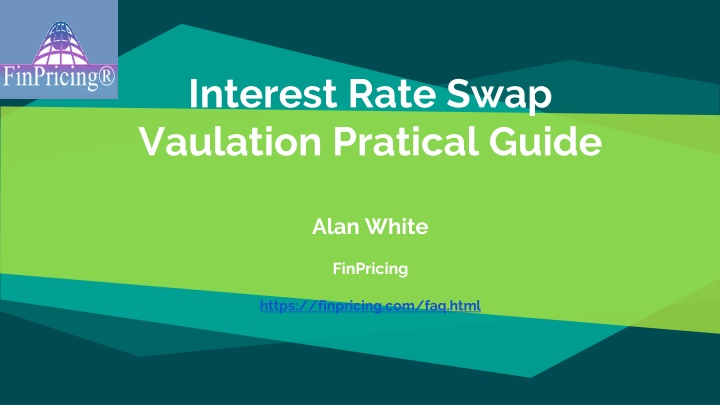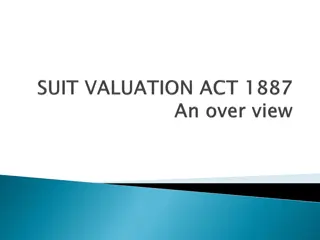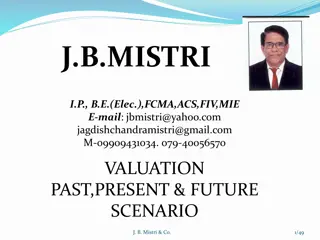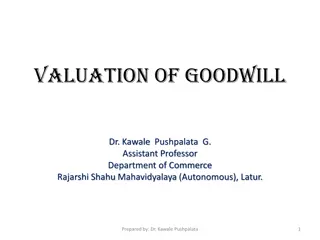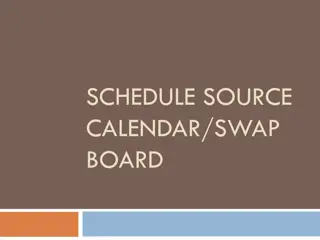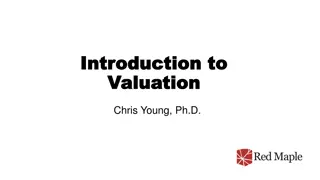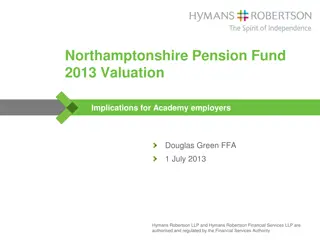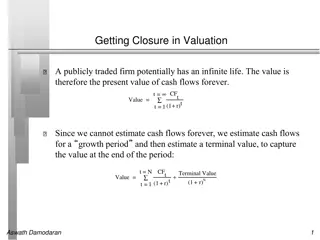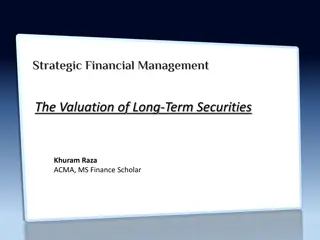Practical Guide to Interest Rate Swap Valuation by Alan White
Understand the concept of interest rate swaps, their practical applications, valuation methods, and real-world examples. Learn about swaplets, fixed and floating legs, and how swaps can be used to manage interest rate exposure.
Download Presentation

Please find below an Image/Link to download the presentation.
The content on the website is provided AS IS for your information and personal use only. It may not be sold, licensed, or shared on other websites without obtaining consent from the author.If you encounter any issues during the download, it is possible that the publisher has removed the file from their server.
You are allowed to download the files provided on this website for personal or commercial use, subject to the condition that they are used lawfully. All files are the property of their respective owners.
The content on the website is provided AS IS for your information and personal use only. It may not be sold, licensed, or shared on other websites without obtaining consent from the author.
E N D
Presentation Transcript
Interest Rate Swap Vaulation Pratical Guide Alan White FinPricing https://finpricing.com/faq.html
Swap Summary Interest Rate Swap Introduction The Use of Interest Rate Swap Swap or Swaplet Payoff Valuation Practical Notes A real world example
Swap Interest Rate Swap Introduction An interest rate swap is an agreement between two parties to exchange future interest rate payments over a set period of time. An interest rate swap consists of a series of payment periods, called swaplets. Vanilla Interest Rate Swaps involve the exchange of a fixed interest rate for a floating rate, or vice versa. There are two legs associated with each party: a fixed leg and a floating leg. Swaps are OTC derivatives that bear counterparty credit risk.
Swap The Use of Interest Rate Swap Swaps are the most popular OTC derivatives that are generally used to manage exposure to fluctuations in interest rates. Swaps can also be used to obtain a marginally lower interest rate. Thus they are often utilized by a firm that can borrow money easily at one type of interest rate but prefers a different type. Swaps allow investors to adjust interest rate exposure and offset interest rate risk. Speculators use swaps to speculate on the movement of interest rates. More and more swaps are cleared through central counterparties (CCPs) nowadays.
Swap Swap or Swaplet Payoff From the fixed rate payer perspective, the payoff of a swap or swaplet at payment date T is given by ??????????= ??(? ?) where N- the notional; ? accrual period in years (e.g., a 3 month period 3/12 = 0.25 years) R the fixed rate in simply compounding. F the realized floating rate in simply compounding From the fixed rate receiver perspective, the payoff of a swap or swaplet at payment date T is given by ?????????????= ??(? ?)
Swap Valuation The present value of a fixed rate leg is given by ? ???????? = ?? ???? ?=1 where t is the valuation date and ??= ?(?,??) is the discount factor. The present value of a floating leg is given by ? ???????? = ? ??+ ? ???? ?=1 ?? 1 ?? 1 /??is the forward rate and s is the floating spread. The present value of an interest rate swap can expressed as From the fixed rate receiver perspective, ?? = ??????? ??????? From the fixed rate payer perspective, ?? = ??????? ??????? where ??=
Swap Practical Notes First of all, you need to generate accurate cash flows for each leg. The cash flow generation is based on the start time, end time and payment frequency of the leg, plus calendar (holidays), business convention (e.g., modified following, following, etc.) and whether sticky month end. We assume that accrual periods are the same as reset periods and payment dates are the same as accrual end dates in the above formulas for brevity. But in fact, they are different due to different market conventions. For example, index periods can overlap each other but swap cash flows are not allowed to overlap. The accrual period is calculated according to the start date and end date of a cash flow plus day count convention
Swap Practical Notes (Cont) The forward rate should be computed based on the reset period (index reset date, index start date, index end date) that are determined by index definition, such as index tenor and convention. it is simply compounded. Sometimes there is a floating spread added on the top of the floating rate in the floating leg. The formula above doesn t contain the last live reset cash flow whose reset date is less than valuation date but payment date is greater than valuation date. The reset value is ???????= ?0??0?0 where ?0is the reset rate.
Swap Practical Notes (Cont) The present value of the reset cash flow should be added into the present value of the floating leg. Some dealers take bid-offer spreads into account. In this case, one should use the bid curve constructed from bid quotes for forwarding and the offer curve built from offer quotes for discounting.
Swap A Real World Example Leg 1 Specification Leg 2 Specification Currency Day Count Leg Type Notional Pay Receive Payment Frequency Start Date End Date Fixed Rate USD dcAct360 Fixed 5000000 Receive 1M 7/1/2015 3/1/2023 0.0455 Currency Day Count Leg Type Notional Pay Receive Payment Frequency Start Date End Date Spread Index Specification Index Type Index Tenor Index Day Count USD dcAct360 Float 5000000 Pay 1M 7/1/2015 3/1/2023 0 LIBOR 1M dcAct360
Thanks! You can find more details at https://finpricing.com/lib/IrSwap.html
